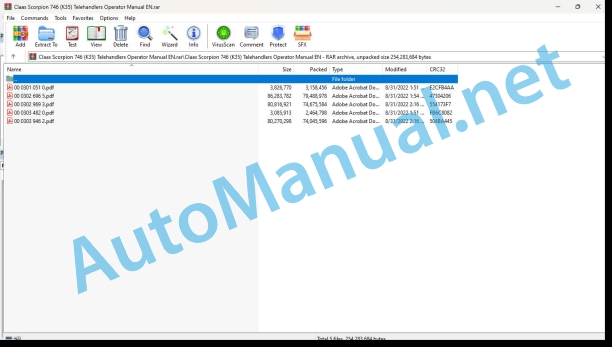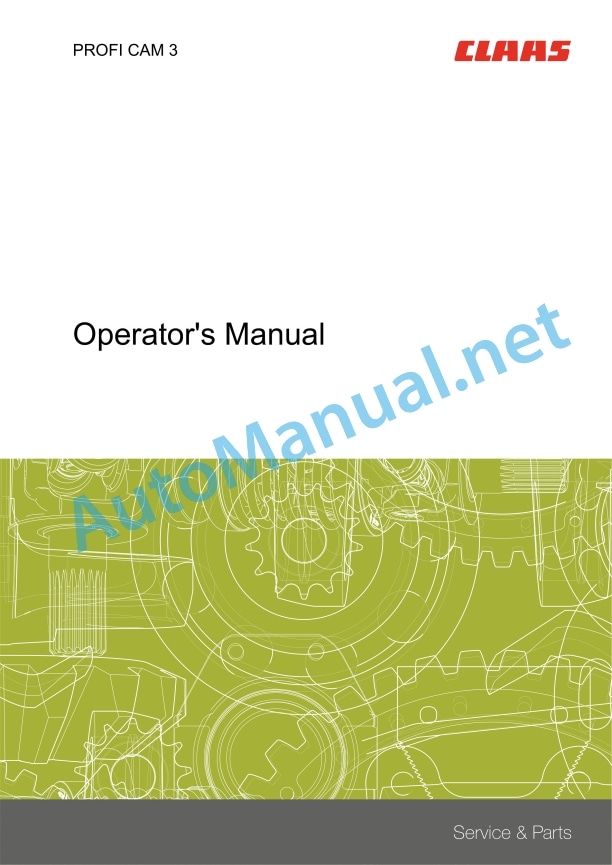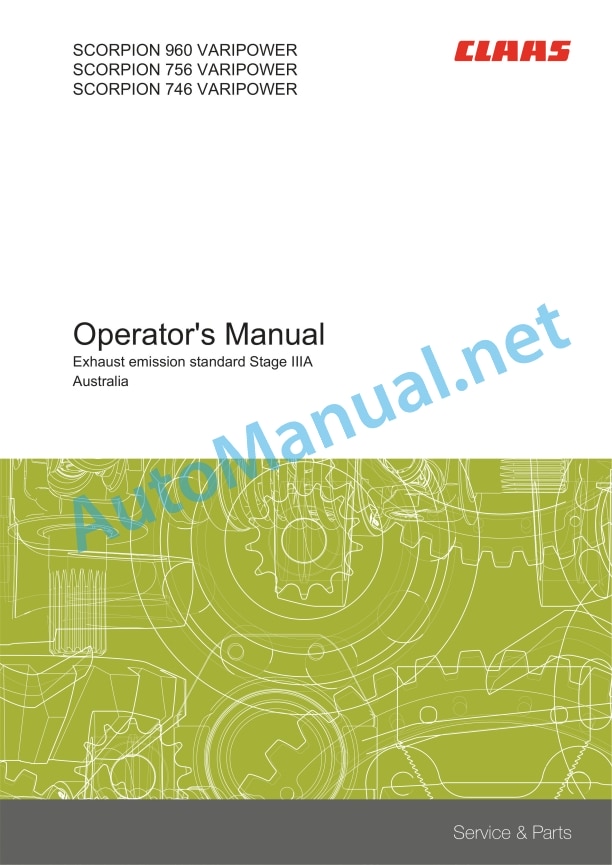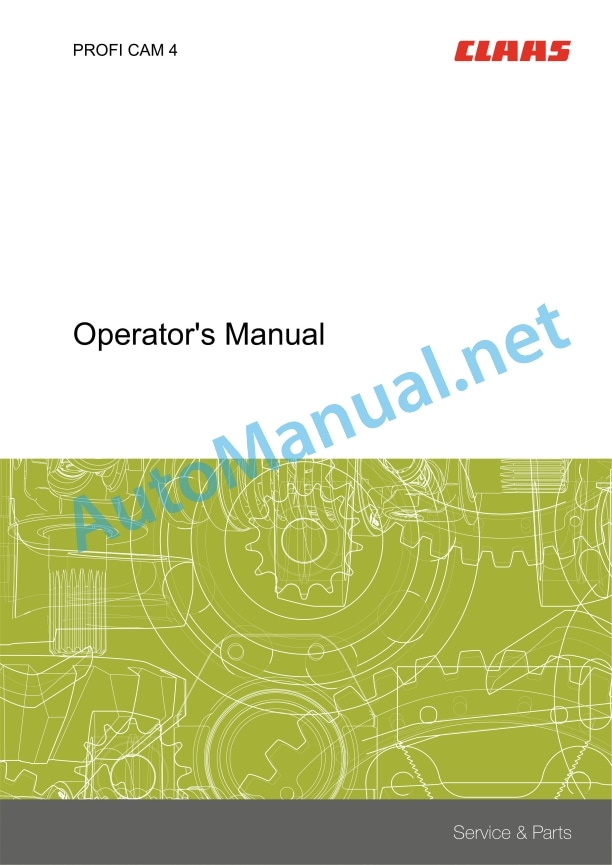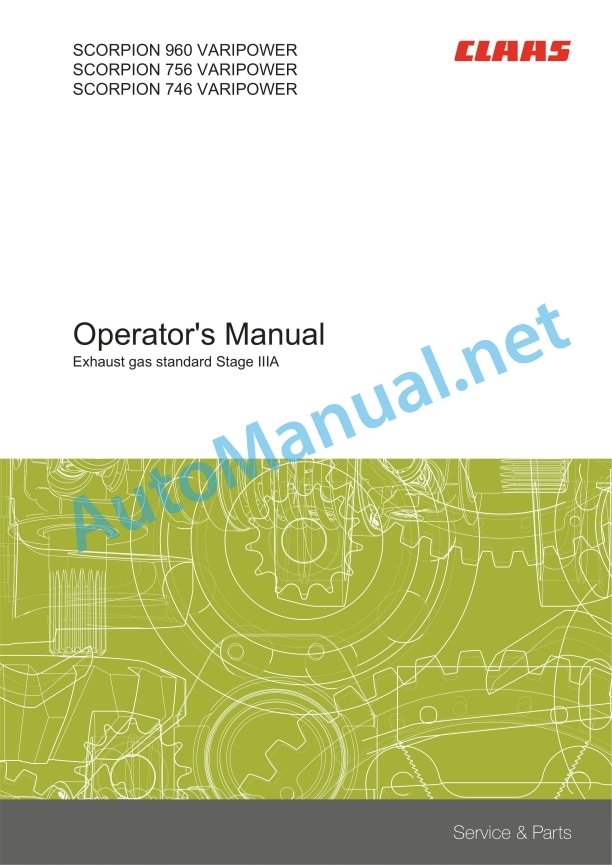Claas Scorpion 746 (K35) Telehandlers Operator Manual EN
$50.00
- Model: Scorpion 746 (K35) Telehandlers
- Type Of Manual: Operator Manual
- Language: EN
- Format: PDF(s)
- Size: 223 MB
File List:
00 0301 051 0.pdf
00 0302 696 5.pdf
00 0302 969 3.pdf
00 0303 482 0.pdf
00 0303 946 2.pdf
00 0301 051 0.pdf:
PROFI CAM 3
Table of contents
1 Introduction
1.1 Notes on the manual
1.1.1 Validity of manual
1.1.2 Information about this Operator’s Manual
1.1.3 Symbols and notes
1.1.4 Optional equipment
1.1.5 Qualified specialist workshop
1.1.6 Maintenance information
1.1.7 Warranty notes
1.1.8 Spare parts and technical questions
1.2 Intended use
1.2.1 Intended use
1.2.2 Reasonably foreseeable misuse
2 Safety
2.1 Identifying warnings
2.1.1 Hazard signs
2.1.2 Signal word
2.2 Safety rules
2.2.1 Meaning of Operator’s Manual
2.2.2 Observing safety decals and warnings
2.2.3 Optional equipment and spare parts
3 Product description
3.1 Overview and method of operation
3.1.1 How the PROFI CAM works
3.2 Identification plates and identification number
3.2.1 Position of identification plates
3.2.2 Explanation of PROFI CAM identification plate
3.3 Information on the product
3.3.1 CE marking
4 Operating and control elements
4.1 Camera system
4.1.1 Camera system monitor
4.2 Menu structure
4.2.1 Main menu
4.2.2
4.2.3
4.2.4
4.2.5
4.2.6
5 Technical specifications
5.1 PROFI CAM
5.1.1 Monitor
5.1.2 Camera
5.1.3 Switch box
5.1.4 Degree of protection against foreign bodies and water
6 Preparing the product
6.1 Shutting down and securing the machine
6.1.1 Switching off and securing the machine
6.2 Prior to operation
6.2.1 Carry out prior to operation
6.2.2 Installing the sun protection
6.2.3 Aligning the camera
6.2.4 Connecting the camera electrics
7 Operation
7.1 Monitor
7.1.1 Switching on the monitor
7.1.2 Calling up the menu
7.1.3 Setting a menu item
7.1.4 Setting the image orientation
7.1.5 Setting automatic screen darkening
7.1.6 Image mirroring
7.1.7 Setting the trigger view
7.1.8 Setting the follow-up time for trigger view
7.1.9 Setting the display mode
7.1.10 Activating/deactivating a display mode
8 Faults and remedies
8.1 Electrical and electronic system
8.1.1 Overview of problems on PROFI CAM camera system
8.1.2 Replacing the switch box fuse
9 Maintenance
9.1 Maintenance intervals
9.1.1 Every 10 operating hours or daily
9.2 Camera system
9.2.1 Checking the camera system for dirt
9.2.2 Cleaning the camera
9.2.3 Cleaning the switch box
9.2.4 Cleaning the monitor
10 Placing out of operation and disposal
10.1 General Information
10.1.1 Putting out of operation and disposal
11 Technical terms and abbreviations
11.1 Abbreviations
11.1.1 Units
11.1.2 Abbreviations
11.1.3 Technical terms
00 0302 696 5.pdf:
SCORPION 960 VARIPOWERSCORPION 756 VARIPOWERSCORPION 746 VARIPOWER
Table of contents
1 Introduction
1.1 General information
1.1.1 Validity of manual
1.1.2 Information about this Operator’s Manual
1.1.3 Symbols and notes
1.1.4 Optional equipment
1.1.5 Qualified specialist workshop
1.1.6 Maintenance notes
1.1.7 Notes on warranty
1.1.8 Spare parts and technical questions
1.2 Intended use
1.2.1 Intended use
1.2.2 Reasonably foreseeable misuse
2 Safety
2.1 Identifying warnings
2.1.1 Hazard signs
2.1.2 Signal word
2.2 Safety rules
2.2.1 Importance of Operator’s Manual
2.2.2 Observing safety decals and warnings
2.2.3 Requirements for all persons working with the machine
2.2.4 Children in danger
2.2.5 Hazard areas
2.2.6 Persons riding on the machine
2.2.7 Hitching the machine to the working attachment
2.2.8 Hitching the machine to the trailer
2.2.9 Structural alterations
2.2.10 Optional equipment and spare parts
2.2.11 Roll-over protective structure and falling object protective structure
2.2.12 Control of the machine while it is running
2.2.13 Operation only following proper putting into operation
2.2.14 Technical condition
2.2.15 Danger from damage to the machine
2.2.16 Respecting technical limit values
2.2.17 Keeping safety devices functional
2.2.18 Personal protective equipment
2.2.19 Wearing suitable clothing
2.2.20 Removing dirt and loose objects
2.2.21 Field of view and viewing aids
2.2.22 Preparing the machine for road travel
2.2.23 Hazards when driving on the road and on the field
2.2.24 Towing or salvaging the machine
2.2.25 Lifted loads
2.2.26 Solid ground
2.2.27 Parking the machine safely
2.2.28 Unsuitable operating utilities
2.2.29 Safe handling of operating and auxiliary utilities
2.2.30 Fuel is harmful to your health
2.2.31 Refrigerant is harmful to your health
2.2.32 Environmental protection and disposal
2.2.33 Keeping the cab free of chemicals
2.2.34 Avoiding fires
2.2.35 Potentially fatal electric shock from electric overhead lines
2.2.36 Behaviour in case of voltage flashover from overhead lines and of lightning strikes
2.2.37 Electrocution by electrical system
2.2.38 Oscillations may damage your health
2.2.39 Pressurised fluids
2.2.40 Toxic exhaust gas
2.2.41 Hot surfaces
2.2.42 Accessing and leaving the machine safely
2.2.43 Working on machine only after shutting it down
2.2.44 Maintenance operations and repair work
2.2.45 Danger from welding work
2.2.46 Checking and charging the battery
2.3 Safety marking
2.3.1 Structure of safety decals
2.3.2 Overview of warning signs
2.3.3 Warning signs on the machine
3 Machine description
3.1 Overview and method of operation
3.1.1 Overview of telehandler
SCORPION 960
SCORPION 756 / 746
3.2 Identification plates and identification numbers
3.2.1 Identification plate of telescopic loader
3.2.2 EC approval
3.2.3 Cab identification plate
3.3 Information on the machine
3.3.1 Position of decals
3.3.2 Decals
Lashing point
Slinging point, lifting point
Windscreen washer liquid
Sound power level
Emergency exit
Ground speed
Urea solution
Hydraulic oil
Lubrication chart
Wheel nuts
Tyre pressure table
Brake fluid
Lifting capacity curve
Control lever
Slow speed device and hand throttle*
Rear hydraulics*
Work lights*
Maximum tongue load*
Rescue point
Tank nozzle
Pre-heating device 230 V*
Manual lubrication points*
Switching position*
High Flow*
Front socket*
Maximum load-carrying capacity*
Pre-heating device 120 V*
Swing axle lock*
Refrigerant*
4 Operating and display elements
4.1 Cab and operator’s platform
4.1.1 Operator’s platform
4.1.2 Front controls
4.1.3 Controls in the side console
4.1.4 Controls in the right-side roof console
4.1.5 Controls in the left-side roof console
4.1.6 Heater and air conditioner controls
4.1.7 Control lever
4.1.8 Control stalk
4.1.9 Ignition lock
4.1.10 Display unit on the steering column
4.1.11 Load moment indicator
4.1.12 Level indicator
4.1.13 Compressed air brake system pressure gauge*
4.1.14 Broadcast radio, socket and USB
4.1.15 Controls on the telescopic arm
4.2 On-board information system
4.2.1 Warnings and fault messages
4.2.2 3.5 display unit
4.2.3 7 display unit*
4.2.4 Status symbols in the display unit
5 Technical specifications
5.1 SCORPION
5.1.1 Dimensions of SCORPION 960
5.1.2 Dimensions of SCORPION 756
5.1.3 Dimensions of SCORPION 746
5.1.4 Weight
5.1.5 Load-carrying capacity
5.1.6 Explanations regarding the lifting capacity curve
Symbols on the lifting capacity curves
5.1.7 SCORPION 960 lifting capacity curve
5.1.8 SCORPION 756 lifting capacity curve
5.1.9 SCORPION 746 lifting capacity curve
5.1.10 Static and dynamic testing
5.1.11 Vertical loads
Calculation of ground pressure
Calculation example for front wheels on solid ground
Calculation example for front wheels on loose ground
Calculation example for rear wheels on solid ground
Calculation example for rear wheels on loose ground
Support area on solid ground
Support area on loose ground
Support area with support
Calculation example of front tyres with support
5.1.12 Vibrations
Hand/arm vibrations
Whole-body vibrations
5.1.13 Sound pressure level and sound power level
5.1.14 Temperature of use
5.1.15 Diesel engine
5.1.16 TCD 4.1 L4 diesel engine
5.1.17 Diesel engine TCD 3.6 L4
5.1.18 TCD 3.6 L4 (D914) diesel engine
5.1.19 CO2 emissions of diesel engine
5.1.20 Chassis
Ground drive
Ground speed
5.1.21 Axles
Front axle
Rear axle
5.1.22 Working attachments
5.1.23 Tyres and tyre pressure
5.1.24 Snow chains* or tyre protection chains*
5.1.25 Foam-filled tyres*
5.1.26 Brake
5.1.27 Steering
5.1.28 Telescopic arm
5.1.29 Trailer hitch
Registration as an agricultural or forestry tractor
Registration as self-propelled working machine
5.1.30 Trailer with hydraulic brake
5.1.31 Electric system
5.1.32 Hydraulic system
5.1.33 Restrictions of field of view in SCORPION 960
Restriction of field of view with load hitched
Restriction of field of view with a load
Restriction of field of view for lorry loading
5.1.34 Restrictions of field of view in SCORPION 756 and SCORPION 746
Restriction of field of view with load hitched
Restriction of field of view with a load
Restriction of field of view for lorry loading
5.1.35 Stability during operation
Conditions for lifting operation
Conditions for transport operation
5.1.36 Stability during operation with lift eye*
Conditions for lifting operation
Conditions for transport operation
5.2 Operating utilities
5.2.1 Lubricants
5.2.2 Hydraulic oil
5.2.3 Brake fluid
5.2.4 Coolant
5.2.5 Fuels
5.2.6 Refrigerant
5.2.7 Windscreen washer liquid
6 Machine preparation
6.1 Switching off and securing the machine
6.1.1 Switching off and securing the machine
6.1.2 Lowering the working attachment to the ground
6.1.3 Switching the battery isolating switch
6.1.4 Securing the machine against rolling away
6.1.5 Stopping the ground drive with the EMERGENCY OFF switch
6.1.6 Engaging the parking position
6.2 Accessing workplaces and maintenance spaces
6.2.1 Accessing and leaving the cab
Accessing and leaving
Accessing the cab
Leaving the cab
6.3 Diesel engine
6.3.1 Selecting the permitted fuel
6.3.2 Observing the fuel specification
6.3.3 Observing the fuel specification
6.3.4 Observing the urea specification
Use of the urea solution
Purity and standard of urea solution
Storage of urea solution in tanks and containers
Properties of urea solution at high and low outside temperatures
6.3.5 Using winter fuel at low temperatures
6.3.6 Refuelling the machine
Refuelling fuel
Filling up urea solution
6.4 Working attachment
6.4.1 Removing the working attachment
6.4.2 Relieving the pressure in the hydraulic system
Relieving the hydraulic pressure in control circuit III
Pressure relief* of control circuit III / control circuit III High Flow*
Relieving the hydraulic pressure in control circuit IV*
6.4.3 Disconnecting the hydraulic lines of control circuit III
Disconnecting the connections of control circuit III
Disconnecting the connections of control circuit III change-over*
Disconnecting the leakage oil connection*
6.4.4 Disconnecting the hydraulic lines of control circuit III High Flow*
6.4.5 Disconnecting the multi-coupler*
6.4.6 Disconnecting the front socket*
6.4.7 Removing the working attachment from the mechanical implement carrier*
6.4.8 Removing the working attachment from the hydraulic implement carrier*
6.4.9 Installing the working attachment
6.4.10 Installing the working attachment on the mechanical implement carrier*
6.4.11 Installing the working attachment on the hydraulic implement carrier*
6.4.12 Connecting the hydraulic lines of control circuit III
Aligning the connections of hydraulic lines
Connecting the connections of control circuit III
Connecting the connections of control circuit III change-over*
Connecting the leakage oil connection*
6.4.13 Connecting the hydraulic lines of control circuit III High Flow*
6.4.14 Connecting the multi-coupler*
6.4.15 Connecting the front socket*
6.4.16 Checking the working attachment lock
Visual inspection
Mechanical check
6.4.17 Connecting the hydraulic lines of control circuit IV*
Connecting the connections of control circuit IV
6.4.18 Disconnecting the hydraulic lines of control circuit IV*
6.4.19 Connecting the rear socket*
6.5 Hitch
6.5.1 Connecting a trailer with a tipper function*
6.5.2 Disconnecting a trailer with a tipper function*
6.6 Loading the machine
6.6.1 Preparing the machine for loading
6.6.2 Loading the machine
6.6.3 Lashing down the machine
6.6.4 Driving the machine on a loading space
6.6.5 Driving the machine from a loading space
7 Operation
7.1 Driving and transportation
7.1.1 Preparing for driving operation
7.1.2 Preparing road travel
7.1.3 Carrying out a function check
7.1.4 Driving
Starting off the machine
7.1.5 Moving the working attachment to transport position
7.1.6 Picking up and unloading the material
7.1.7 Levelling
Forward levelling
Backward levelling
7.1.8 Loading a transport vehicle
7.1.9 Picking up a load from the ground
7.1.10 Picking up a load from an elevated point
7.1.11 Putting the load down on the ground
7.1.12 Putting down a load at an elevated point
7.1.13 Towing the machine from the hazard area
Towing points and salvaging points
Preparing the machine for towing
Towing the machine
After towing
7.1.14 Loading cycle counter*
Counting the loading cycles
Resetting the loading cycle counter
7.2 Diesel engine
7.2.1 Starting the diesel engine
Synchronizing the steering
Warming up the hydraulic oil to operating temperature
7.2.2 Switching off the diesel engine
7.2.3 Pre-heating device for hydraulic oil and coolant (230 / 120 V)*
Activating pre-heating
Deactivating pre-heating
7.2.4 Fuel pre-heating device (12 V)*
7.3 Chassis
7.3.1 Selecting the direction of travel
7.3.2 Selecting the driving range
7.3.3 Slow speed device*
7.3.4 Level compensation*
Tilting the machine
Reading the cross inclination angle on the level display in the cab
Reading the cross inclination angle on the level display on the swing axle
7.3.5 Vibration damping*
7.3.6 Hand throttle*
7.3.7 Engaging and disengaging the differential lock*
7.3.8 Activating four-wheel drive disengaging*
7.3.9 Engaging and disengaging the hydraulic swing axle lock*
7.3.10 Engaging and disengaging the mechanical swing axle lock*
Locking the swing axle
Unlocking the swing axle
Locking the swing axle
Unlocking the swing axle
7.3.11 Opening and closing the ground drive pump high-pressure valves
7.4 Brake
7.4.1 Braking the machine
7.4.2 Applying and releasing the parking brake
7.4.3 Releasing and applying the parking brake mechanically (SCORPION 960 / 756)
Releasing the parking brake
Close the parking brake
7.4.4 Releasing and applying the parking brake mechanically (SCORPION 746)
Releasing the parking brake
Applying the parking brake
7.5 Steering
7.5.1 Setting the steering mode
Setting front wheel steering
Setting 4-wheel steering
Setting crab steering
Setting manual crab steering without lock key
Setting manual crab steering with lock key
Correcting the rear axle steering angle
7.6 Working attachment
7.6.1 Preparing working with the working attachment
7.6.2 Blocking and releasing the working hydraulics
7.6.3 Function of load moment indicator
7.6.4 Checking the load moment indicator
7.6.5 Working hydraulics fine control*
7.6.6 Raising and lowering the telescopic arm
Raising the telescopic arm
Lowering the telescopic arm
7.6.7 Extending and retracting the telescopic boom
Extending the telescopic boom
Retracting the telescopic boom
7.6.8 Automatic telescopic boom retract*
7.6.9 Tipping the working attachment out and in
Tipping in the working attachment
Tipping out the working attachment
7.6.10 Automatic bucket return*
7.6.11 Vibrating and shaking function*
7.6.12 Control circuit III
Operating control circuit III
Setting the flow rate*
Changing over control circuit III*
7.6.13 Control circuit III High Flow*
Operating the control circuit III High Flow
Setting the flow rate*
7.6.14 Control circuit IV*
Operating control circuit IV
Setting the flow rate
7.6.15 Tipping cylinder lock*
7.6.16 Emergency lowering*
Activating emergency lowering
7.6.17 Engaging and disengaging DYNAMIC POWER*
7.7 Hitch
7.7.1 Overview of trailer hitches
7.7.2 Operating the automatic trailer hitch
Adjusting the trailer hitch height
Hitching the trailer
Unhitching the trailer
7.7.3 Operating the Piton trailer hitch
Adjusting the trailer hitch height
Hitching the trailer
Unhitching the trailer
7.7.4 Operating the ball-type hitch
Adjusting the trailer hitch height
Adjusting the hold-down clip height
Hitching the trailer
Unhitching the trailer
7.7.5 Operating the Cuna trailer hitch
Adjusting the trailer hitch height
Hitching the trailer
Unhitching the trailer
7.7.6 Operating the manoeuvring hitch
Hitching the trailer
Unhitching the trailer
Hitching the trailer
Unhitching the trailer
7.7.7 Operating the automatic pin-type hitch
Hitching the trailer
Unhitching the trailer
7.7.8 Operating the pin-type hitch
Hitching the trailer
Unhitching the trailer
7.7.9 Operating the hitch hook
7.7.10 Connecting the trailer to the compressed air brake system*
7.7.11 Operating the compressed air brake*
7.7.12 Switching the antifreeze pump for the compressed-air brake system* on and off
7.7.13 Connecting the hydraulic trailer brake*
7.7.14 Operating the hydraulic trailer brake*
7.7.15 Operating a trailer with tipper function*
Raising and lowering the tipper
7.8 Electric and electronic system
7.8.1 Electronic immobiliser*
Programming the ignition key
Deleting an ignition key
7.8.2 Camera system*
7.8.3 Reversing warning system
Reversing horn
7.8.4 Setting the warning beacon*
Switching the warning beacon on and off
Removing the warning beacon
Folding down the warning beacon*
7.8.5 Switching the side light on and off
7.9 Cab and operator’s platform
7.9.1 Opening the emergency exit
7.9.2 Adjusting the driver’s seat
7.9.3 Adjusting the arm rest
Adjusting the height of the armrest
Adjusting the armrest horizontally
Adjusting the inclination and depth of the armrest
7.9.4 Applying the seat belt
7.9.5 Adjusting the steering column
Adjusting the distance of the steering wheel
Adjusting the steering wheel height
Adjusting the steering wheel inclination
7.9.6 Adjusting heater, ventilation and air conditioner*
Setting the temperature
Setting the fan
Switching the air conditioner* on and off
7.9.7 Opening and closing the cab window
Open the upper cab door section a little
Opening the upper part of the cab door by 180°
Opening the rear cab window
7.9.8 Adjusting the roll-up sun screen*
7.9.9 Switching the cab interior lighting on and off
7.9.10 Adjusting the internal and external mirrors
7.9.11 Adjusting the trailer mirror*
7.9.12 Actuating the windscreen washer system
Actuating the windscreen washer system
Actuating the rear windscreen washer system
Actuating the side window* washer system
7.9.13 Removing the front protection*
7.10 Central lubrication ystem
7.10.1 Central lubrication system*
8 Faults and remedies
8.1 Overview
8.1.1 Resetting the maintenance indicator
8.1.2 Overview of fault codes
8.1.3 Overview of fault codes
8.2 Diesel engine
8.2.1 Overview of diesel engine faults
8.2.2 Overview of faults on air filter system
8.2.3 Overview of exhaust treatment system faults
Warning and malfunction strategies
Symbols of urea tank
Exhaust gas treatment system symbols
Diesel particulate filter* symbols
Override output reduction
8.3 Brake
8.3.1 Overview of faults on the brake system
8.4 Steering
8.4.1 Overview of faults on the steering system
8.5 Working attachment
8.5.1 Overview of faults on the working attachment
8.6 Hydraulic system
8.6.1 Overview of faults on the hydraulic system
8.7 Electric and electronic system
8.7.1 Jump-start process
Connecting the external battery
Disconnecting the external battery
8.7.2 Overview of faults on the electric system
8.7.3 Overview of faults on electronic immobilizer*
8.7.4 Fuses in engine compartment
8.7.5 Fuses in the cab
8.7.6 Relays in engine compartment
8.7.7 Relays in the cab
8.7.8 Preparing welding work
8.8 Cab and operator’s platform
8.8.1 Overview of faults on the heating system
Heating output
Cooling capacity
8.9 Central lubrication system
8.9.1 Overview of faults on the central lubrication system*
9 Maintenance
9.1 Preparing maintenance
9.1.1 Moving the machine to the maintenance position
9.1.2 Applying the safety lock
9.1.3 Opening and closing the engine bonnet
9.2 Maintenance intervals
9.2.1 Every 10 operating hours or daily
9.2.2 Every 50 operating hours
9.2.3 After the first 100 operating hours
9.2.4 Every 250 operating hours
9.2.5 After the first 500 operating hours
9.2.6 Every 500 operating hours
9.2.7 Every 1000 operating hours
9.2.8 Every 1500 operating hours
9.2.9 Every 2 years
9.2.10 Every 2000 operating hours
9.2.11 Every 3000 operating hours
9.2.12 Every 4000 operating hours
9.2.13 Every 6000 operating hours
9.2.14 Every 10000 operating hours
9.3 Lubrication chart
9.3.1 Lubricating the lubrication points every 50 operating hours
Central lubrication points*
Hitch hook* and lift eye*
9.3.2 Grease points, grease every 250 operating hours
9.4 Diesel engine
9.4.1 Cleaning the diesel engine
9.4.2 Difficulty factors for
9.4.3 Checking the diesel engine oil level (TCD 3.6 L4 / TCD 3.6 L4 (D914))
Checking the oil level
Topping up oil
9.4.4 Checking the diesel engine oil level (TCD 4.1 L4)
Topping up oil
9.4.5 Draining condensed water from the fuel prefilter (TCD 3.6 L4)
9.4.6 Draining condensed water from the fuel prefilter (TCD 3.6 L4 (D914))
9.4.7 Draining condensed water from the fuel prefilter (TCD 4.1 L4)
9.4.8 Draining condensed water and sediments from the fuel tank
9.4.9 Bleeding the fuel system (TCD 3.6 L4 / TCD 3.6 L4 (D914))
9.4.10 Cleaning the cooling system (TCD 3.6 L4 / TCD 3.6 L4 (D914))
9.4.11 Cleaning the cooling system (TCD 4.1 L4)
9.4.12 Adjusting the reversing fan*
9.4.13 Checking the coolant level (TCD 3.6 L4 / TCD 3.6 L4 (D914))
Checking the filling level
Topping up coolant
9.4.14 Checking the coolant level (TCD 4.1 L4)
Checking the filling level
Topping up coolant
9.4.15 Cleaning or changing the air filter elements (TCD 3.6 L4 (D914))
Removing the filter element
Cleaning the filter housing and the lid
Replacing the safety element
Installing the filter element
9.4.16 Cleaning or replacing air filter elements (TCD 4.1 L4 / TCD 3.6 L4)
Removing the filter element
Cleaning the filter element
Cleaning the filter housing and the lid
Replacing the safety element
Installing the filter element
9.4.17 Cleaning the air filter dust discharge valve (TCD 3.6 L4 (D914))
Cleaning the dust discharge valve
Checking the dust discharge*
9.4.18 Cleaning the air filter dust discharge valve (TCD 4.1 L4 / TCD 3.6 L4)
Cleaning the lid
Cleaning the dust discharge valve
9.4.19 Regenerating the exhaust aftertreatment system
Automatic regeneration
Starting regeneration manually
Cancelling regeneration
Regenerating the diesel particulate filter*
9.5 Chassis
9.5.1 Checking the tyre pressure
9.5.2 Checking the tightening torque of wheel nuts
9.6 Brake
9.6.1 Checking the function and effect of the service brake
9.6.2 Checking the function and effect of the parking brake
9.6.3 Dewatering the compressed air reservoir of the compressed air brake*
9.7 Steering
9.7.1 Checking the steering system function
9.8 Telescopic arm
9.8.1 Greasing the sliding faces on the telescopic boom
9.8.2 Greasing the rear sliding elements
9.8.3 Checking the front sliding elements
Removing the scrapers*
Checking the sliding elements
Replacing the sliding elements
9.8.4 Preserving the connecting rods
9.9 Hydraulic system
9.9.1 Checking the hydraulic oil level
Checking the filling level
Topping up hydraulic oil
9.9.2 Checking the hydraulic hoses
Marking of hydraulic hoses
9.10 Electric and electronic system
9.10.1 Checking the lighting
9.10.2 Checking the load moment limitation function
Preparing the machine
Checking the load moment limitation with the standard fork
Checking the load moment limitation with a special fork
9.11 Cab and operator’s platform
9.11.1 Checking the condition and function of the seat belt
9.11.2 Cleaning or replacing the cab air pre-filter*
9.11.3 Checking the filling level in the windscreen washer system
9.12 Central lubrication system
9.12.1 Checking the grease level in the central lubrication system*
Checking the filling level
Topping up grease
9.13 Assembled parts and machine housing
9.13.1 Cleaning the machine
Prior to cleaning
Cleaning
After cleaning
9.13.2 Checking the fire extinguishers
10 Putting out of operation and disposal
10.1 General information
10.1.1 Removal from service and disposal
11 Declaration of Conformity
11.1 SCORPION
11.1.1 EC declaration of conformity (sample)
00 0302 969 3.pdf:
SCORPION 960 VARIPOWERSCORPION 756 VARIPOWERSCORPION 746 VARIPOWER
Table of contents
1 Introduction
1.1 General information
1.1.1 Validity of manual
1.1.2 Information about this Operator’s Manual
1.1.3 Symbols and notes
1.1.4 Optional equipment
1.1.5 Qualified specialist workshop
1.1.6 Maintenance notes
1.1.7 Notes on warranty
1.1.8 Spare parts and technical questions
1.2 Intended use
1.2.1 Intended use
1.2.2 Reasonably foreseeable misuse
2 Safety
2.1 Identifying warnings
2.1.1 Hazard signs
2.1.2 Signal word
2.2 Safety rules
2.2.1 Importance of Operator’s Manual
2.2.2 Observing safety decals and warnings
2.2.3 Requirements for all persons working with the machine
2.2.4 Children in danger
2.2.5 Hazard areas
2.2.6 Persons riding on the machine
2.2.7 Hitching the machine to the working attachment
2.2.8 Hitching the machine to the trailer
2.2.9 Structural alterations
2.2.10 Optional equipment and spare parts
2.2.11 Roll-over protective structure and falling object protective structure
2.2.12 Control of the machine while it is running
2.2.13 Operation only following proper putting into operation
2.2.14 Technical condition
2.2.15 Danger from damage to the machine
2.2.16 Respecting technical limit values
2.2.17 Keeping safety devices functional
2.2.18 Personal protective equipment
2.2.19 Wearing suitable clothing
2.2.20 Removing dirt and loose objects
2.2.21 Field of view and viewing aids
2.2.22 Preparing the machine for road travel
2.2.23 Hazards when driving on the road and on the field
2.2.24 Towing or salvaging the machine
2.2.25 Lifted loads
2.2.26 Solid ground
2.2.27 Parking the machine safely
2.2.28 Unsuitable operating utilities
2.2.29 Safe handling of operating and auxiliary utilities
2.2.30 Fuel is harmful to your health
2.2.31 Refrigerant is harmful to your health
2.2.32 Environmental protection and disposal
2.2.33 Keeping the cab free of chemicals
2.2.34 Avoiding fires
2.2.35 Potentially fatal electric shock from electric overhead lines
2.2.36 Behaviour in case of voltage flashover from overhead lines and of lightning strikes
2.2.37 Electrocution by electrical system
2.2.38 Oscillations may damage your health
2.2.39 Pressurised fluids
2.2.40 Toxic exhaust gas
2.2.41 Hot surfaces
2.2.42 Accessing and leaving the machine safely
2.2.43 Working on machine only after shutting it down
2.2.44 Maintenance operations and repair work
2.2.45 Danger from welding work
2.2.46 Checking and charging the battery
2.3 Safety marking
2.3.1 Structure of safety decals
2.3.2 Overview of warning signs
2.3.3 Warning signs on the machine
3 Machine description
3.1 Overview and method of operation
3.1.1 Overview of telehandler
SCORPION 960
SCORPION 756 / 746
3.2 Identification plates and identification numbers
3.2.1 Identification plate of telescopic loader
3.2.2 Supplement to identification plate
3.2.3 Cab identification plate
3.3 Information on the machine
3.3.1 Position of decals
3.3.2 Decals
Lashing point
Slinging point, lifting point
Windscreen washer liquid
Sound power level
Emergency exit
Ground speed
Urea solution
Hydraulic oil
Lubrication chart
Wheel nuts
Tyre pressure table
Brake fluid
Lifting capacity curve
Control lever
Slow speed device and hand throttle*
Rear hydraulics*
Work lights*
Maximum tongue load*
Rescue point
Tank nozzle
Pre-heating device 230 V*
Manual lubrication points*
Switching position*
High Flow*
Front socket*
Maximum load-carrying capacity*
Swing axle lock*
Lifting and transporting
Extension dimension
Refrigerant*
4 Operating and display elements
4.1 Cab and operator’s platform
4.1.1 Operator’s platform
4.1.2 Front controls
4.1.3 Controls in the side console
4.1.4 Co
John Deere Repair Technical Manual PDF
John Deere Parts Catalog PDF
John Deere Harvesters 8500 and 8700 Parts Catalog CPCQ24910 Spanish
John Deere Repair Technical Manual PDF
John Deere Parts Catalog PDF
John Deere Tractors 7500 Parts Catalog CPCQ26568 30 Jan 02 Portuguese
John Deere Repair Technical Manual PDF
John Deere Diesel Engines POWERTECH 2.9 L Component Technical Manual CTM126 Spanish
John Deere Repair Technical Manual PDF
John Deere Repair Technical Manual PDF
John Deere Repair Technical Manual PDF
John Deere Transmission Control Unit Component Technical Manual CTM157 15JUL05
John Deere Repair Technical Manual PDF
John Deere 16, 18, 20 and 24HP Onan Engines Component Technical Manual CTM2 (19APR90)

